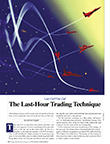LETTERS TO THE EDITOR
December 2012 Letters To The Editor
The editors of S&C invite readers to submit their opinions
and information on subjects relating to technical analysis and this magazine.
This column is our means of communication with our readers. Is there something
you would like to know more (or less) about? Tell us about it. Without a source
of new ideas and subjects coming from our readers, this magazine would not
exist.
Address your correspondence to: Editor, Stocks & Commodities,
4757 California Ave. SW, Seattle, WA 98116-4499, or E-mail to editor@traders.com.
All letters become the property of Technical Analysis, Inc. Letter-writers
must include their full name and address for verification. Letters may
be edited for length or clarity. The opinions expressed in this column do not
necessarily represent those of the magazine. —Editor
LAST-HOUR TRADING TECHNIQUES
 Editor,
Editor,
I read Ashwani Gujral’s August 2012 article in S&C (“Last-Hour Trading Techniques”). It presents a really nice idea. I would like to know: How many years of data did he use in his backtest (2000–2012?). Which data vendor did he use and which software backtesting tool? How many stocks are included in the backtest? How many of the Indian stocks are liquid, and does he use a liquidity filter?
I’m in Germany, and my research shows that only around 100-150 German stocks are “tradable” from a liquidity point of view. Did Gujral test markets other than the Indian stock market for this idea?
Joachim Lenz
Germany
Author Ashwani Gujral replies:
Let’s get straight to your questions:
- I have tested this strategy over the last two years (with real money). I would think this strategy would work on most days because there is always activity somewhere in the market.
- Since this strategy falls under the category of discretionary strategies or perhaps since I am more of a discretionary trader, I have not used software for backtesting; I instead tested it in actual trading. Perhaps someone who is a better programmer than I could run a backtest using one of the popular programs with backtesting capabilities.
- I took three calls a day for about 500 days out of a list of 200 companies, because in India, we have individual futures only on those 200 companies.
- All technical analysis is ideally applied to very liquid stocks, and we have about 200 companies that are liquid. In my experience, you can find ideas from those 200 shares.
MORE ON LAST-HOUR TRADING TECHNIQUES
Editor,
Thank you for Ashwani Gujral’s article in the August 2012 issue of S&C, “Last-Hour Trading Techniques.” I found it very informative. I did have three areas I was hoping he can clarify for me:
- With an 80% win percentage, would you be willing to share your risk/reward ratio for this system?
- Do you exit/take profit at 2% automatically, realizing a better percentage return if the market is moving quickly and you get filled at a better position?
- During your backtesting, were you able to determine the system’s profit factor, and if so, would you be willing to share it?
David
Author Ashwani Gujral replies:
Thanks for your email. Let me answer point-wise:
- I tend to take three trades instead of one, so the risk-reward is on the entire portfolio. The entire portfolio should not start losing, say, more than 3%, ideally. Risk control is done in two ways. First, the entire market should not turn against you, the odds of which are low, since you are getting in after watching the trend all day. Remember, the whole portfolio should not lose more than 3%. Second, all positions are exited 15 minutes after the opening, so win or lose, you do not carry it beyond the next day’s open plus 15 minutes. I have tested this using real money for the last one and a half years, which is much better than testing it mechanically.
- Exits 2% or better are in your favor; 90% of the time, when the trades don’t work, you get out about breakeven since you are entering in the direction of momentum. So either it’s 2% or better in your favor, or the whole portfolio goes against you by 3%, or definitely next day’s open plus 15 minutes, which ensures you do not carry losers. Three percent works because this outcome happens very infrequently.
- The basic idea remains capital protection. When you see things not working out, just bail out and wait until the next day. This works because you are controlling losses all the time. The profit factor should be in the region of 4 to 5. It’s tough to model this into software because it’s all about exits, and market environment plays a big role.
Originally published in the December 2012 issue of Technical Analysis of Stocks & Commodities magazine. All rights reserved. © Copyright 2012, Technical Analysis, Inc.
Return to
Contents
 Editor,
Editor,